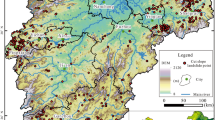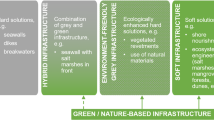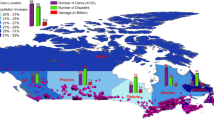Abstract
Taiwan has disadvantageous conditions for sediment-related disasters such as debris flows. The construction of engineering structures is an effective strategy for reducing debris flow disasters. However, it is impossible to construct engineering structures in all debris flow areas in a short period. Therefore, the government aims to gradually develop non-structural preventive strategies, including evacuation planning, debris flow disaster emergency action system, disaster resistant community program, recruitment of debris flow professional volunteers, debris flow warning systems, and land management strategies, to mitigate disasters and secure the safety of residents. This review describes the processes and effects of recent debris flow non-structural preventive strategies in Taiwan. The average number of casualties prior to the year 2000 was far higher than the corresponding number after 2000 because debris flow evacuation drills have been promoted since 2000 and the debris flow disaster emergency action system has been progressively improved since 2002. Furthermore, the changes in risks caused by debris flow disasters before and after the implementation of non-structural preventive strategies were used to explain the effectiveness of these strategies at the community level. The results showed that software-based non-structural preventive strategies can effectively reduce the casualties caused by debris flows at both the national and community levels.
Similar content being viewed by others
References
Central Weather Bureau (2013) FAQ for Earthquake. Chinese Taipei. Available online: http://scweb.cwb.gov.tw/News Content.aspx?ItemId=37&CId=190&loc=en (Accessed on 12 October 2013).
Chen CY, Yu FC, Lin SC, et al. (2007) Discussion of landslide self-organized criticality and the initiation of debris flow. Earth Surface Processes and Landforms 32(2): 197–209. DOI: 10.1002/esp.1400
Chen JC, Jan CD (2003) Probabilistic estimation for the critical slope of debris-flow occurrence. Proceedings of the Third International Conference on Debris-Flow Hazards Mitigation. Davos, Switzerland. pp 83–90.
Chen RH, Lin ML, Chen H (1993) Preliminary study of the material properties of the debris flow at Tungmen. Journal of Chinese Soil and Water Conservation 24(1): 65–74. (In Chinese)
Chen SC (2002) Knowledge about debris flow disaster prevention. Presented at the meeting of Natural Hazard of Slope-land Conference for High School Teachers, Taiwan. (In Chinese)
Chen SC (2009) The soil and water conservation strategies affected by global warming. Report of SWCB 98-062. (In Chinese)
Chen SC, Ferng JW, Wang YT, et al. (2008) Assessment of disaster resilience capacity of hillslope communities with high risk for geological hazards. Engineering Geology 98(3–4): 86–101. DOI: 10.1016/j.enggeo.2008.01.008
Chen SC, Huang BT (2010) Non-structural mitigation programs for sediment-related disasters after the Chichi Earthquake in Taiwan. Journal of Mountain Science 7(3): 291–300. DOI: 10.1007/s11629-010-2021-3
Chen SC, Wu CY, Huang BT (2010) The efficiency of a risk reduction program for debris-flow disasters — A case study of the Songhe community in Taiwan. Natural Hazards and Earth System Sciences 10(7): 1591–1603. DOI: 10.5194/nhess-10-1591-2010
Chen SC, Wu CY, Wu TY (2009) Resilient capacity assessment for geological failure areas: examples from communities affected by debris flow disaster. Environmental Geology 56(8): 1523–1532. DOI: 10.1007/s00254-008-1251-y
Chiang YC, Lin YY (1987) Preliminary study on the characteristics of deposition of debris flow. Journal of Chinese Soil and Water Conservation 18(2): 15–27. (In Chinese)
Chiang YC, Wu DS (1990) Experiments on preventing debrisflow by A-type Slit Dam. Journal of Chinese Soil and Water Conservation 21(2):29–43. (In Chinese)
Fan JC, Mao CT (1997) Rainfall characteristics at the places where debris flows had ever occurred in Shon-Lm, Hua-Lien. Journal of Chinese Soil and Water Conservation 28(1): 47–58. (In Chinese)
Ikeya, H, Mizuyama T (1982) Flow and deposit properties of debris flow. Public Works Research Institute, 157: 88–153. (In Japanese)
Jan CD (1993) Dynamic internal friction angles of idealized debris flows. Journal of Chinese Soil and Water Conservation 24(1): 29–36. (In Chinese)
Jan CD (1994) Assessment and prediction of debris flow hazards. Journal of Chinese Soil and Water Conservation 25(2): 95–102. (In Chinese)
Jan CD, Chen JC, Hwang GW (1996) Application of kinematic wave model to 1-D debris flow routing. Journal of Chinese Soil and Water Conservation 27(2): 119–126. (In Chinese)
Jan CD, Lee MH (2004) A debris-flow rainfall-based warning model. Journal of Chinese Soil and Water Conservation 35(3): 275–285. (In Chinese)
Jan CD, Lee MH, Huang TH (2003) Rainfall threshold criterion for debris flow initiation. 2002 Annual Meeting on Hazards Mitigation Research. Taipei, Taiwan. pp 8-1–8-17.
Jan CD, Lee MH, Wang JS (2004a) A rainfall-based debris-flow warning model and its application in Taiwan. Proceedings of the 2004 International Conference on Slopeland Disaster Mitigation. Chinese Taipei. pp 111–119.
Jan CD, Shen HW (1990) Longitudinal surface profiles of granular debris flows. Proceeding of International Symposium on Hydraulics and Hydrology of Arid Lands. USA. pp 530–536.
Jan CD, Shieh CL, Tsang YC, et al. (2004b) Debris-flow hazardzone mapping in Taiwan. International Workshop on Hazard Zone Mapping of Hillslope. Taiwan. pp 7-1–7-4.
Jeng RC, Chiang YC (1986) Preliminary study on the characteristics of occurrence of debris flow. Journal of Chinese Soil and Water Conservation 17(2): 50–69. (In Chinese)
Ko YC, Chen SC (2004) Designated Soil and Water Conservation Area: past research, present strategy and future direction. Journal of Chinese Soil and Water Conservation 35(2): 165–175. (In Chinese)
Lee SW (1986) Comparison in sabo work between Austria and Taiwan. Journal of Chinese Soil and Water Conservation 17(2): 15–26. (In Chinese)
Li MH, Chiang YC (1989) Experiments on controlling debrisflow with grid type dams. Journal of Agriculture and Forestry 38(2):191–216. (In Chinese)
Lien H, Tsai F (2003) Sediment concentration distribution of debris flow. Journal of hydraulic dngineering 129(12): 995–1000. DOI: 10.1061/(ASCE)0733-9429(2003)129:12(995)
Lien HP, Su CG, Chiang YC (1994) Study on the mechanism of debris flow. Journal of Chinese Soil and Water Conservation 25(3): 151–160. (In Chinese)
Lin PS, Feng TY, Lee CM (1993) A study on the initiation characteristics of debris flow in gravelly deposits. Journal of Chinese Soil and Water Conservation 24(1): 55–64. (In Chinese)
Lin PS, Lin JY, Hung JC, et al. (2002) Assessing debris-flow hazard in a watershed in Taiwan. Engineering Geology 66(3–4): 295–313. DOI: 10.1016/S0013-7952(02)00105-9
Ling CH, Chen CL, Jan CD (1990) Rheological properties of simulated debris flows in the laboratory environment. Proceeding of International Symposium on Hydraulics and Hydrology of Arid Lands. USA. pp 218–224.
Liu KF, Huang MC (2002) The numerical simulation of debris flows and its application in Shen-Mu Village. Journal of Chinese Soil and Water Conservation 33(3): 215–222. (In Chinese)
Liu SC, Shiu CJ, Chen JP, et al. (2008) Changes of precipitation intensity in East Asia. Paper presented at the meeting of 2008 Symposium of Climate Changes in Taiwan, Chinese Taipei.
Lu SJ (2013) Sediment trapping and removing efficiency by slit check dam with steel. Master thesis, National Chung-Hsing University, Chinese Taipei. (In Chinese)
Shieh CL, Chen LJ (1993) A study on the danger ranks of potential debris flows. Journal of Chinese Soil and Water Conservation 24(1): 13–20. (In Chinese)
Shieh CL, Jan CD, Tsai YF (1996) A numerical simulation of debris flow and its application. Natural Hazards 13(1): 39–54. DOI: 10.1007/BF00156505.
Shieh CL, Jiang JH, Chen LJ (1992) Field investigation of debris flow in Hualien and Taitung Counties. Journal of Chinese Soil and Water Conservation 23(2): 109–122. (In Chinese)
Soil and Water Conservation Bureau (2005) The Report of integrated planning for debris flow disaster in Songhe community, Taichung County, Taiwan. (In Chinese)
Soil and Water Conservation Bureau (2007) 2006 Debris flow annual report. Taiwan. (In Chinese)
Soil and Water Conservation Bureau (2008a) 2007 Debris flow annual report. Taiwan. (In Chinese)
Soil and Water Conservation Bureau (2008b) The achievement of debris flow disaster prevention. Taiwan. (In Chinese)
Soil and Water Conservation Bureau (2013) The management system of debris flow preparedness. Available online: http://210.69.127.223/dfdv/default.htm (Accessed on 15 October 2013)
Takahashi T (1991) Debris flow. IAHR Monograph Series, Balkema, Rotterdam, The Netherlands.
Wang HP, Huang YH, Yeh ML, et al. (2009) Debris flow monitoring events in Taiwan during Typhoon MORAKOT. Journal of Chinese Soil and Water Conservation 40(4): 311–328. (In Chinese)
Wang WW (2009) Dam removal effects on bed form variations and structural stability analyses for the steel dam. Master Thesis, National Chung-Hsing University, Taiwan. (In Chinese)
Wang YY, Tan RZ, Jan CD, et al. (2009) Gravel accumulation in deposits of viscous debris flows with hyper-concentration. Journal of Mountain Science 6(1): 88–95. DOI: 10.1007/s11629-009-0120-9
Wu CH, Chen SC, Feng ZY (2013) Formation, failure and consequences of the Xiaolin landslide dam, triggered by extreme rainfall from Typhoon Morakot, Taiwan. Landslides, DOI: 10.1007/s10346-013-0394-4
Yang MD, Lin YY, Yao CY (2011) Landslide-induced levee failure by high concentrated sediment flow — A case of Shan-An levee at Chenyulan River, Taiwan. Engineering Geology 123(1–2): 91–99. DOI: 10.1016/j.enggeo.2011.07.006.
Yu FC (1992) Studies on the characteristics of deposition of debris flow (II) on the deposition forms of debris flow. Journal of Chinese Soil and Water Conservation 23(1): 1–16. (In Chinese)
Yu FC, Chen CK (1987) A study on the debrisflow disasters at Peng-Chiou. Journal of Chinese Soil and Water Conservation 18(1): 76–92. (In Chinese)
Yu FC, Chen CK (1990) Basic study on the debris flow (II) preliminary study on the flow velocity of debris flow. Journal of Soil and Water Conservation 21–22(1): 115–142. (In Chinese)
Author information
Authors and Affiliations
Corresponding author
Rights and permissions
About this article
Cite this article
Chen, SC., Wu, CY. Debris flow disaster prevention and mitigation of non-structural strategies in Taiwan. J. Mt. Sci. 11, 308–322 (2014). https://doi.org/10.1007/s11629-014-2987-3
Received:
Accepted:
Published:
Issue Date:
DOI: https://doi.org/10.1007/s11629-014-2987-3




